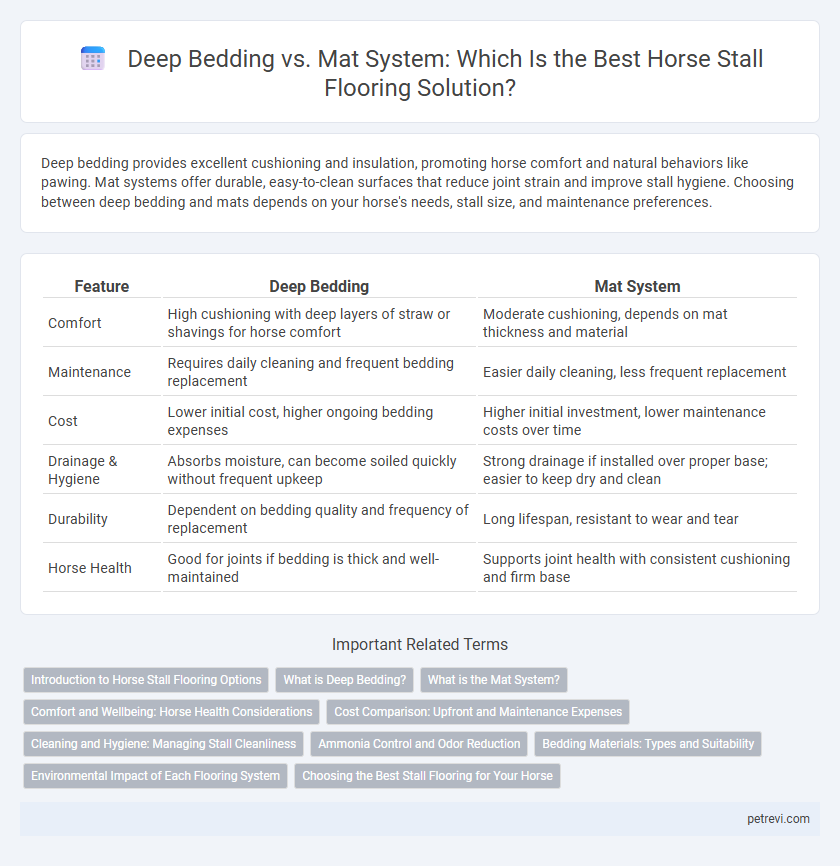Deep bedding provides excellent cushioning and insulation, promoting horse comfort and natural behaviors like pawing. Mat systems offer durable, easy-to-clean surfaces that reduce joint strain and improve stall hygiene. Choosing between deep bedding and mats depends on your horse's needs, stall size, and maintenance preferences.
Table of Comparison
| Feature | Deep Bedding | Mat System |
|---|---|---|
| Comfort | High cushioning with deep layers of straw or shavings for horse comfort | Moderate cushioning, depends on mat thickness and material |
| Maintenance | Requires daily cleaning and frequent bedding replacement | Easier daily cleaning, less frequent replacement |
| Cost | Lower initial cost, higher ongoing bedding expenses | Higher initial investment, lower maintenance costs over time |
| Drainage & Hygiene | Absorbs moisture, can become soiled quickly without frequent upkeep | Strong drainage if installed over proper base; easier to keep dry and clean |
| Durability | Dependent on bedding quality and frequency of replacement | Long lifespan, resistant to wear and tear |
| Horse Health | Good for joints if bedding is thick and well-maintained | Supports joint health with consistent cushioning and firm base |
Introduction to Horse Stall Flooring Options
Horse stall flooring options significantly impact equine comfort, hoof health, and stall maintenance efficiency. Deep bedding systems provide ample cushioning and absorbency through thick layers of straw, shavings, or sawdust, promoting natural behaviors and moisture control. Mat systems offer durable, non-slip surfaces that reduce joint stress and simplify cleaning, often combined with a thin layer of bedding for added comfort.
What is Deep Bedding?
Deep bedding in horse stall flooring involves using a thick layer of absorbent material, such as straw, wood shavings, or sawdust, typically six to twelve inches deep, to provide comfort and insulation for the horse. This system promotes natural behaviors like pawing and nesting, while effectively managing moisture and ammonia buildup by trapping urine below the surface. Compared to mat systems, deep bedding offers superior cushioning, thermal protection, and ease of waste removal when maintained properly.
What is the Mat System?
The Mat System for horse stall flooring consists of high-density rubber mats designed to provide a durable, non-slip surface that enhances comfort and reduces joint strain for horses. These mats offer excellent cushioning and drainage capabilities, promoting hygiene by preventing moisture buildup and minimizing ammonia exposure. Compared to traditional deep bedding, the Mat System requires less maintenance and provides a consistent, supportive environment ideal for stall rest or turnout.
Comfort and Wellbeing: Horse Health Considerations
Deep bedding systems provide superior cushioning and absorption, promoting joint comfort and reducing the risk of pressure sores in horses. Mat systems offer consistent support and easier cleanup, helping maintain a dry and hygienic environment that minimizes hoof and skin infections. Selecting the optimal flooring depends on factors such as horse age, health conditions, and daily stall usage to enhance overall equine wellbeing.
Cost Comparison: Upfront and Maintenance Expenses
Deep bedding systems for horse stall flooring typically incur higher upfront costs due to the volume of material required, but they offer better shock absorption and moisture control, potentially reducing veterinary expenses. Mat systems, while involving a substantial initial investment for high-quality rubber mats, generally lower maintenance expenses by minimizing bedding replacement frequency and simplifying cleaning processes. Over time, the cost-effectiveness of mats versus deep bedding depends on factors such as bedding material prices, labor costs, and the horse's specific health needs related to footing and comfort.
Cleaning and Hygiene: Managing Stall Cleanliness
Deep bedding systems absorb moisture effectively, reducing odor and providing a comfortable, sanitary environment for horses. Mat systems offer easier daily cleaning by allowing removal of manure and waste without disturbing the stall base, promoting quicker maintenance. Proper management of both systems is crucial to prevent ammonia buildup and maintain optimal hygiene in horse stalls.
Ammonia Control and Odor Reduction
Deep bedding systems absorb and trap ammonia emissions more effectively than mat systems by allowing organic material to break down naturally, reducing harmful gases and unpleasant odors. Mat systems with non-absorbent surfaces can increase ammonia concentration if not paired with frequent cleaning and appropriate absorbent layers. Optimal ammonia control and odor reduction in horse stalls depend on proper management and ventilation alongside the choice of flooring type.
Bedding Materials: Types and Suitability
Deep bedding systems use thick layers of straw, shavings, or sawdust to provide cushioning, moisture absorption, and insulation, making them ideal for horses requiring extra comfort and warmth. Mat systems rely on rubber or foam mats that offer durable support and easier cleaning but may require supplemental bedding like shavings or pellets to enhance moisture control and prevent slipping. Selecting bedding materials depends on factors such as horse health, stall usage, and climate, with straw favored for breathability, shavings for absorbency, and mats for stability and longevity.
Environmental Impact of Each Flooring System
Deep bedding systems create substantial organic waste, which can be composted to reduce landfill impact but require significant water and material resources for maintenance. Mat systems minimize waste generation by offering a reusable surface, yet their manufacturing involves synthetic materials that contribute to environmental pollution and end-of-life disposal challenges. Evaluating the carbon footprint and resource use of each option is critical for sustainable horse stall management.
Choosing the Best Stall Flooring for Your Horse
Deep bedding provides superior cushioning and absorbency, promoting healthier hooves and reducing joint stress for horses. Mat systems offer durability and ease of cleaning, making them a practical choice for high-traffic stalls. Evaluating your horse's specific needs, stall usage, and maintenance capacity ensures the best flooring choice for optimal comfort and hygiene.
Deep Bedding vs Mat System for Horse Stall Flooring Infographic

 petrevi.com
petrevi.com